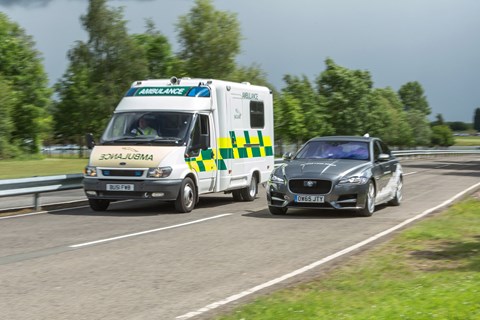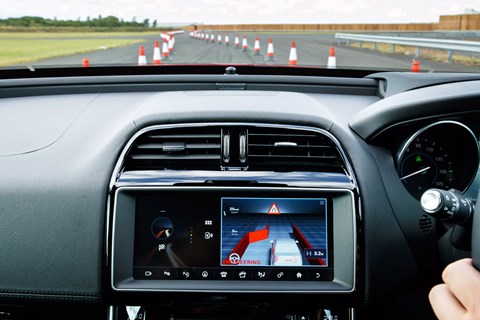► JLR researching safety and comms tech
► Designed to cut accidents and stress
► Real-world tests begin later this year
You’re at a roundabout, sat behind another car. It’s been sat there for ages, about four feet back from the road, and refuses to budge. Suddenly, the written invitation they’ve been awaiting arrives – and they begin to roll forwards.
The freedom of the open road lies ahead, and you gladly roll on the throttle. It’s still all clear to the right. You’re a careful motorist, after all, so would always check. Your eyes flick back to the dead-ahead position – and the pootling motorist in front isn’t moving any more. But they are two seconds later, as you promptly punt them into the roundabout.
A ‘Safe Pullaway’ feature, designed to prevent that kind of incident, is one of several technologies that Jaguar Land Rover intends to trial soon. By the end of the year, the company will be carrying out real-world tests of its latest safety and communications systems, all of which are designed to reduce the risk of accidents and cut driver stress.
The tests will take place over a four-year period and eventually involve more than 100 research vehicles. JLR states that the first of these test cars will operate on a 41-mile test route around Coventry, taking in motorway routes and urban roads.
So what will Jaguar Land Rover initially be testing?
A series of vehicle-to-vehicle and vehicle-to-infrastructure communications systems, which will allow drivers to receive early alerts about upcoming road conditions – helping ease congestion, cut journey times and avoid traffic-related frustrations.

Tony Harper, head of research at Jaguar Land Rover, said: ‘If you are a keen driver, imagine being able to receive a warning that there’s a hazard out of sight or around a blind bend. Whether it’s a badly parked car or an ambulance heading your way, you could slow down, pass the hazard without fuss and continue on your journey.’
What other safety systems will be tested?
There’s the aforementioned ‘Safe Pullaway’, which monitors vehicles or obstructions in front of the car when stationary and protects against drivers inadvertently moving off into them. It also prevents drivers selecting a forward gear when parked nose in, and driving into a wall or bollard.
JLR will also be testing a ‘Roadwork Assist’ pack, which uses the car’s cameras to identify cones and barriers. It will help guide the car, with gentle steering input, to keep it centred in the lane and safe from damage.

Lastly, the company will put its ‘Over the Horizon Warning’ and ‘Emergency Vehicle Warning’ systems to the test. The over-the-horizon warning relies on car-to-car communications, and delivers alerts to drivers about hazards ahead – like a car parked on a blind corner, which the driver ahead had to swerve to avoid.
The emergency vehicle warning does what it says on the tin, by letting drivers know how far away an approaching emergency vehicle it is. Usefully, the system will also let you know which direction it’s approaching from – so you can better prepare for its arrival.
What’s all this for?
Outside of improving safety and cutting driver workload and stress, real-world trials of these systems will allow JLR to build up a library of data that can be used to better develop fully autonomous cars. The company is, after all, aiming to have autonomous cars on the road by 2021.
Here’s hoping, however, that government bodies work to ensure actual driving ability is maintained – or improved – and not further degraded by the reliance on increasingly prevalent assistance systems…
Read more CAR tech news and features here
